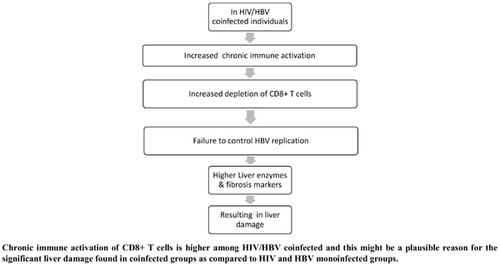Current HIV Research ( IF 0.8 ) Pub Date : 2021-06-30 , DOI: 10.2174/1570162x19666210506160642 John Paul Demosthenes 1 , Gnanadurai John Fletcher 1 , Uday George Zachariah 2 , George Mannil Varghese 3 , Susanne Alexander Pulimood 4 , Priya Abraham 1 , Rajesh Kannangai 1

|
Background: Chronic immune activation is one of the most widely recognized hallmarks of HIV infection. T-cells that express CD38+ and HLA-DR+ show poor proliferative potential, signal transduction, and increased apoptotic potential. This affects HIV pathogenesis and its outcome and further complicates with a coinfection like HBV.
Methods: Study Design: cross-sectional. Blood samples were collected and analyzed for virological markers using ELISA for HBeAg and RT-PCR for HIV&HBV Viral load. Chronic immune activation markers of CD8+ and CD4+ T cells were measured by Flow cytometry for both HIV and HBV.
Results: There was a significant increase in HBV replication shown by higher HBV DNA (p=0.002), a higher proportion of HBeAg (p=0.0049), and lower CD4 counts (p=0.04) among HIV/HBV coinfected individuals, compared to the monoinfected groups. The frequencies of CD4+ CD38+ HLA-DR+ and CD8+ CD38+ HLA-DR+ in the HIV/HBV coinfection were significantly higher than HBV monoinfected group (P< 0.0001) and in the HIV monoinfected group (P < 0.0001). The Liver fibrosis score APRI and FIB-4, were higher in the coinfected group compared with HBV monoinfected group (0.67 vs. 0.25, p = 0.0085; 3.48 vs. 0.98, p = 0.0026) respectively. The cytokine levels of IL-17, Fas-L,TNF -α, IL-10, IL-2 and Granzyme B were also measured and compared among the study groups.
Conclusion: Our data suggest that HIV probably influences immune activation of CD4+ and CD8+ T cells and this may play a significant role in accelerating the disease outcome among HIV/HBV coinfected individuals.
中文翻译:

印度南部未接受过治疗的 HIV/HBV 合并感染个体的慢性免疫激活
背景:慢性免疫激活是 HIV 感染最广泛公认的标志之一。表达 CD38+ 和 HLA-DR+ 的 T 细胞表现出较差的增殖潜能、信号转导和增加的凋亡潜能。这会影响 HIV 的发病机制及其结果,并进一步使合并感染如 HBV 复杂化。
方法:研究设计:横断面。收集血样并使用 ELISA 检测 HBeAg 和 RT-PCR 检测 HIV 和 HBV 病毒载量,分析病毒学标志物。CD8+ 和 CD4+ T 细胞的慢性免疫激活标志物通过流式细胞术测量 HIV 和 HBV。
结果:与 HIV/HBV 共感染个体相比,HBV DNA 较高 (p=0.002)、HBeAg 比例较高 (p=0.0049) 和 CD4 计数较低 (p=0.04) 表明 HBV 复制显着增加。单感染组。HIV/HBV合并感染中CD4+ CD38+ HLA-DR+和CD8+ CD38+ HLA-DR+的频率显着高于HBV单一感染组(P<0.0001)和HIV单一感染组(P<0.0001)。与HBV单一感染组相比,合并感染组的肝纤维化评分APRI和FIB-4分别更高(0.67 vs. 0.25,p = 0.0085;3.48 vs. 0.98,p = 0.0026)。还测量并比较了研究组之间的IL-17、Fas-L、TNF-α、IL-10、IL-2和粒酶B的细胞因子水平。
结论:我们的数据表明,HIV 可能影响 CD4+ 和 CD8+ T 细胞的免疫激活,这可能在加速 HIV/HBV 合并感染个体的疾病结果中发挥重要作用。











































 京公网安备 11010802027423号
京公网安备 11010802027423号